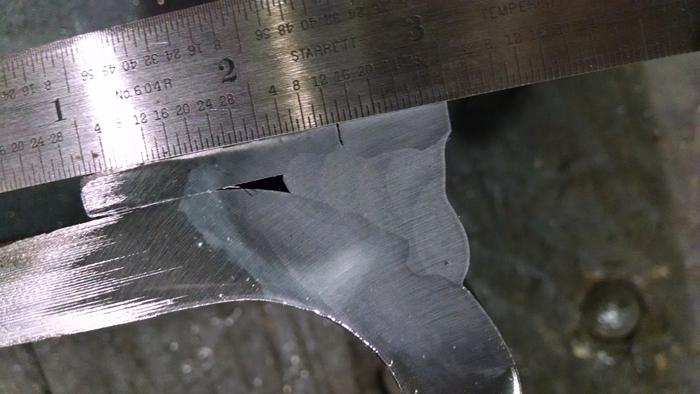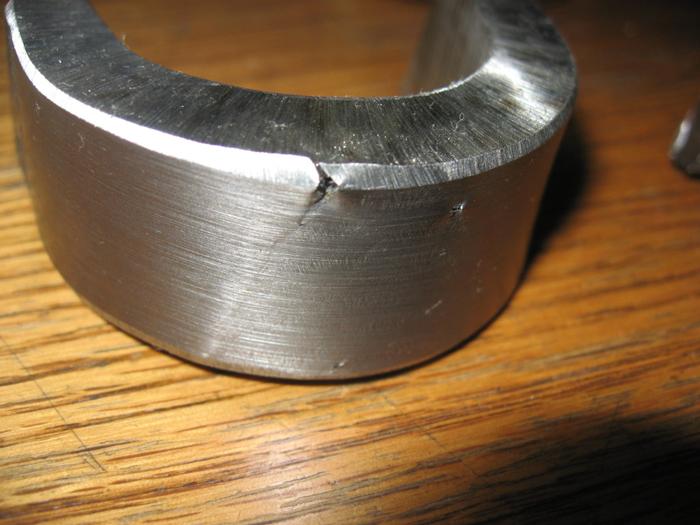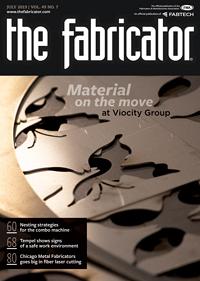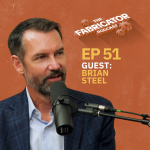Senior Editor
- FMA
- The Fabricator
- FABTECH
- Canadian Metalworking
Categories
- Additive Manufacturing
- Aluminum Welding
- Arc Welding
- Assembly and Joining
- Automation and Robotics
- Bending and Forming
- Consumables
- Cutting and Weld Prep
- Electric Vehicles
- En Español
- Finishing
- Hydroforming
- Laser Cutting
- Laser Welding
- Machining
- Manufacturing Software
- Materials Handling
- Metals/Materials
- Oxyfuel Cutting
- Plasma Cutting
- Power Tools
- Punching and Other Holemaking
- Roll Forming
- Safety
- Sawing
- Shearing
- Shop Management
- Testing and Measuring
- Tube and Pipe Fabrication
- Tube and Pipe Production
- Waterjet Cutting
Industry Directory
Webcasts
Podcasts
FAB 40
Advertise
Subscribe
Account Login
Search
5 steps to code welding success
It starts with good communication and documentation
- By Tim Heston
- Updated October 25, 2023
- July 16, 2019
- Article
- Arc Welding
Metal fabrication has a lot of moving parts. The more complex a project becomes, the more moving parts it has, incorporating a variety of skilled trades and professionals: mechanical, coating, designers, engineers, architects. The number of variables that need to be accounted for to achieve a successful, structurally sound, and safe fabrication project can be truly mind-boggling.
In Paul Cameron’s view, this is exactly why welding codes exist. “Having the correct documentation to back up your welding helps protect the manufacturer,” he said. “When you’re dealing in code-level work, if something goes terribly wrong with a welded component, people will come to your weld shop to find how the failure occurred. They might find that they don’t know how you welded a certain component, because you don’t have documented weld procedures. All that documentation protects the manufacturer when things go wrong.” This applies to any code, be it from the American Welding Society (AWS), American Society of Mechanical Engineers (ASME), American Petroleum Institute (API), or elsewhere.
The Five Code Welding Steps
Cameron speaks from experience. He’s a certified welding inspector (CWI) and nondestructive testing technician at Braun Intertec Corp., Rochester, Minn. He travels the country and audits operations large and small to ensure weld quality is being maintained and, not least, the requirements spelled out by the welding code are satisfied. So what can shop managers do to ensure their code-level welding operation is protected? Cameron detailed five essential steps.
1 Institute Best Communication Practices
Cameron recalled a recent shop visit where welders received jobs with the typical documentation. The documents seemed to be complete, but one specification caused problems. It demanded that when workers weld a specific grade (in this case, A992 Grade 65), they use a specific 80-KSI electrode. Weld shop managers thought the requirement was reasonable, so they sent those documents with the job down to the floor, and that was that. Problem was, as welders received structural beam after beam for this project, they had no way of knowing what grade of material they were actually welding.
“The operation needed to institute some way that would allow the welders to identify the material,” Cameron said.
Welders in this fab shop spoke multiple languages, so managers didn’t want to rely on written identification. Nor did they want identification to fall off as the beam moved down the plant floor. The shop went with a simple solution. At the receiving dock, workers verified the grade and spray-painted an orange mark on Grade 65 material. When welders saw orange spray paint, they knew they had to use a specific electrode.
Cameron clarified that best communication practices apply to every welding operation, not just those performing code-level work. Without these communication fundamentals, a welding shop will find it difficult to succeed, even if it employs welders with every qualification under the sun.
2 Know the Difference Between “Qualified” and “Certified”
“So many weld shops say they have certified welders, but they really don’t,” Cameron said. “They’re not trying to deceive anyone; they just don’t know what the term means.”
A “certified welder” must be certified not by the welder’s employer but by a third party. Regardless of where the certification comes from, welders must meet the requirements, and the third party provides documentation to prove it.
“Also, the industry has different certifications for specific codes, positions, pipe diameters, material thicknesses,” Cameron added. “There are lots of specifics. If you say you’re a certified welder, I know that you’re certified in whatever the third-party documentation tells me you can do. But can you weld what I need you to weld? If it’s not in that documentation, I really don’t know. Maybe you’re certified in shielded metal arc welding [SMAW, or stick], but the job requires flux cored arc welding [FCAW].”

Flare bevel joints are common in structural fabrication. But for code-level work, welders must be qualified to weld this joint geometry.
The vast majority of code-level welders in North America are not certified by a third party. They are instead “qualified welders.” That is, their employer or union tests and qualifies them to perform specific processes, positions, and thicknesses, as determined by the welding code that’s called for in the contract documents.
The jargon can be confusing—and can make for imprecise contract documents. “I often see contract documents stating that the job needs to be done by welders certified to AWS D1.1. If they meant it, it would be a costly proposition. Almost always, they mean they want welders qualified to AWS D1.1.”
3 Follow the Codes the Contract Documents Specify
“I’m often called to a weld shop to bring it up to code,” Cameron said. “I hear things like, ‘My customer never requested a welding procedure before, and now they want one. What gives?’ I then ask, ‘Well, what code did the customer specify in the contract documents? Are you welding to AWS D1.1, or maybe D1.3?’ Then they tell me they don’t have a copy of the code.”
Cameron then goes back to the contract documents and sees the phrase: “Welding per AWS D1.1, current revision.”
“That means everything has to be to that code,” Cameron said, “and I mean everything. That includes the welder qualification test record (WQTR), the procedure qualification record (PQR), and the welding procedure specification (WPS).”
4 Qualify Welding Procedures per the Code
In common welding codes like AWS D1.1 and others, a procedure qualification record (PQR) must support a welding procedure specification (WPS).
As Cameron explained, a WPS can use a PQR that’s been developed, tested, and proven to be a sound process. It’s very specific, entailing a particular welding process, consumable, wire feed speed, voltage, current, travel speed of every weld pass, and more.
The PQR shows the specifics of the weld test and the ensuing inspection results, such as the destructive and nondestructive testing results of test coupons. “We test to ensure the weld meets the minimum ultimate tensile strength of the base material,” Cameron said. The WPS is written using the PQR’s test data, giving the welder a range for the recorded parameters in the PQR (like ±10 percent of the PQR’s wire feed, ±7 percent of voltage, travel, etc.).
Alternatively, the WPS can be considered prequalified. How can you tell whether a job can use a prequalified WPS? “It depends on the code,” Cameron said, “and each code gives you specific parameters to follow. For instance, a procedure can be prequalified only if you’re using a specific material, welding in a specific position, a specific weld joint geometry, at these positions, progressions, currents and voltages. If you stay within all those parameters, you can write a WPS without testing for a PQR. But if one parameter is outside [what the code specifies for a prequalified WPS], you have to do a physical test.”
5 Qualify the Welder per the Code
A shop could have incredibly talented welders, trained and tested to meet the company’s high standards. Company-specific welder training and testing can be a great thing. But they still don’t protect a welding operation if those welder tests don’t satisfy the code and follow a specific WPS.
“Companies with weld tests often miss the fact that, to do the specific [code-level] welding the customer is asking for, our codes require very specific tests. It could be a butt-joint test on 3/8 or 1-in. plate, or 12-in pipe,” Cameron said. “First off, welders would need to do it in a specific position. Once they’ve passed the test in that position, they are allowed to weld only in the positions qualified. But they wouldn’t be qualified to weld in other positions that the particular test didn’t qualify.”
Welders might pass that horizontal groove weld test on 3/8-in.-thick plate. “I then walk into the shop and find them welding in the vertical-down position. That wouldn’t be allowed,” Cameron said. “It’s easy to make a weld that looks nice in that position, but you might not get the quality you want.” Quite often he conducts a destructive test on a beautiful-looking weld made in the vertical-down position—“and I get weld failure after failure after failure.”
Gravity makes the vertical-down welding position deceiving. The molten metal travels downward fast, which means the welding gun needs to travel fast as well. “Many people don’t do it correctly,” Cameron said. “They do it slowly, and they start using the welding gun like a caulking gun, applying layers but not fusing into the previous pass in any way.”
Cameron sees similar welder qualification problems when it comes to material thickness. If a welder is qualified per AWS D1.1, that’s great—but it also means that he or she can weld only a specific thickness range, starting at 0.125 in. “Then you walk into the weld shop and see those welders [performing code-level work] on 12- and 16-gauge sheet metal.”
If welders need to perform code-level welding on thinner material, “they need to be qualified to AWS D1.3, which is the structural code for sheet metal.” Cameron added that, ideally, this should be spelled out in the contract documents.
Yet another common welder qualification issue has to do with the weld joint geometry. As Cameron explained, “Say a welder is qualified to weld on groove welds in the flat position, as well as fillet welds in the flat and horizontal position. That encompasses quite a bit of what’s done in a typical fabrication shop.”
That’s great—but then you see a worker welding a piece of square tubing. The tube is on its side, parallel with the base plate below. That square tubing has rounded corners, which produces a flare bevel groove weld joint geometry between the plate and tube. “I often walk into the shop and see this,” Cameron said. “The individuals welding these quite often aren’t qualified in that position.”
Cameron’s final point about welder qualification: Don’t forget about the continuity log. “When you pass a welder qualification test, that test usually is good for eternity as long as you continue to weld with that process or never go longer than six months without welding with that process.”
Consider someone who transfers from the shop, where he performed gas metal arc welding (GMAW), to the field, where he uses SMAW exclusively. He then returns to the plant job more than six months later. That person would need to be requalified.
“It can be a simple record,” Cameron said. “You don’t need to make it more complicated than it needs to be. In the past I’ve used a simple spreadsheet, with the name of welders on one axis and the welding process on the other—GMAW, FCAW, gas tungsten arc welding, etc.”
Every five months he’d walk to the floor to verify that each welder was performing processes for which they were qualified, then record the date. He’d print it, sign it, and scan it as a PDF and file electronically, so he could access it with a few mouse clicks.
Think of a code-level welding job like a three-legged stool, with the customer requirements as its seat. One leg is the PQR, which qualifies the procedure. The other is the WPS, which instructs the welder. The last leg is the WQTR.
Think of the continuity log as the floor. This proves that all welders remain qualified. If the floor isn’t solid (that is, the continuity log is incomplete or nonexistent), the entire stool becomes unstable.
Eliminating Ambiguity in Code Welding
So many workers who enter metal fabrication learn via tribal knowledge. Ask a press brake operator, plasma cutting machine operator, or any number of other fabrication specialists and they’ll probably tell you that they learned by doing, either on their own or by shadowing someone with more experience. Specific techniques aren’t written down.
Welders learn by doing too, but when it comes to code-level work, those processes are well-documented. The CWIs and welding managers reading the codebooks also know nomenclature designed to minimize ambiguity. Ambiguity can wreak havoc on large construction and industrial projects, and some are so complex that it’s impossible to eliminate all ambiguity up and down the supply chain. The unexpected is bound to happen sometimes. But as Cameron explained, if the weld shop follows its contract documents and, most importantly, the current version of the welding codes, it’s protected.
“If you have the paper trail the codes require to support the quality work you do, and you produce quality work with documented inspection results, you’ve protected your welding operation,” Cameron said. “That’s why the welding codes are there.”
Paul Cameron, CWI, is a weld and NDE Level II inspector, Braun Intertec, Rochester, Minn. He is also a member of The WELDER’s Editorial Review Committee. The WELDER is a sister publication of The FABRICATOR.
About the Author

Tim Heston
2135 Point Blvd
Elgin, IL 60123
815-381-1314
Tim Heston, The Fabricator's senior editor, has covered the metal fabrication industry since 1998, starting his career at the American Welding Society's Welding Journal. Since then he has covered the full range of metal fabrication processes, from stamping, bending, and cutting to grinding and polishing. He joined The Fabricator's staff in October 2007.
subscribe now

The Fabricator is North America's leading magazine for the metal forming and fabricating industry. The magazine delivers the news, technical articles, and case histories that enable fabricators to do their jobs more efficiently. The Fabricator has served the industry since 1970.
start your free subscription- Stay connected from anywhere

Easily access valuable industry resources now with full access to the digital edition of The Fabricator.

Easily access valuable industry resources now with full access to the digital edition of The Welder.

Easily access valuable industry resources now with full access to the digital edition of The Tube and Pipe Journal.
- Podcasting
- Podcast:
- The Fabricator Podcast
- Published:
- 04/09/2024
- Running Time:
- 63:55
In this podcast episode, Brian Steel, CEO of Cadrex Manufacturing, discusses the challenges of acquiring, merging, and integrating...
- Industry Events
16th Annual Safety Conference
- April 30 - May 1, 2024
- Elgin,
Pipe and Tube Conference
- May 21 - 22, 2024
- Omaha, NE
World-Class Roll Forming Workshop
- June 5 - 6, 2024
- Louisville, KY
Advanced Laser Application Workshop
- June 25 - 27, 2024
- Novi, MI

































